COTHAM MARBLE: THE MOST BEAUTIFUL STROMATOLITE IN THE WORLD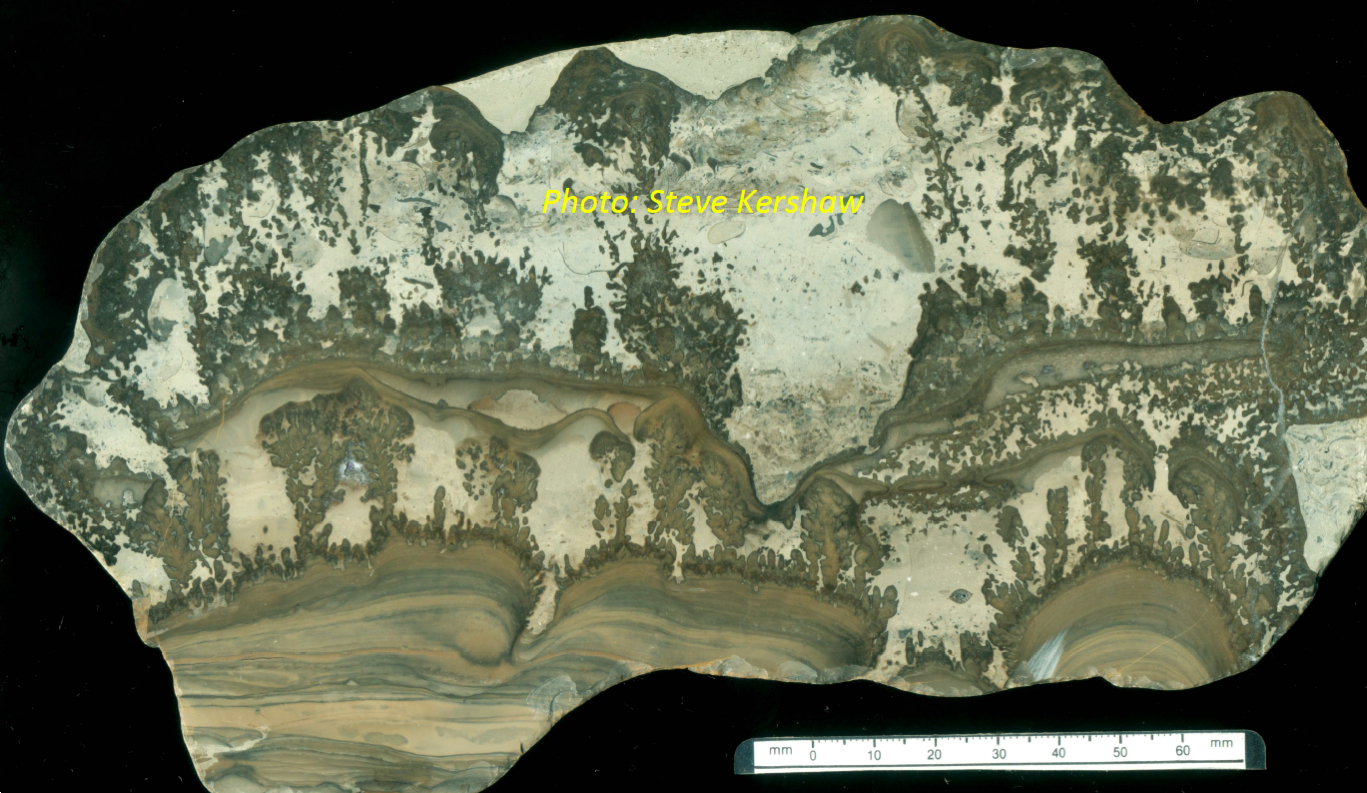
COTHAM MARBLE: THE MOST BEAUTIFUL STROMATOLITE IN THE WORLD
This photo shows a polished vertically-cut slab of the most amazing stromatolite, from the Late Triassic of southwest-central England and Wales
1) WHAT IS IN THIS SECTION OF THE WEBSITE?
At the end of the Triassic Period (about 190 million years ago), across a large area of the southwest part of England and parts of south Wales was the development of a very thin limestone (only about 20 cm thick) of a highly intricate deposit that, for me, is one of the most attractive limestones in the world. It is called Cotham Marble, although it is not marble, it is limestone. Marble, in contrast, is a metamorphosed limestone (it has been subjected to heat and pressure in the Earth's crust), but the Cotham Marble is in a sequence of rocks that has never been subjected to metamorphism because no major compressive tectonic forces had a significant impact on the area where it is found. Cotham Marble is part of a sedimentary deposit in a huge area of shallow water on the margins of the oceans, and is likely to have been formed in a large intertidal flat across parts of southern England and south Wales.
Cotham Marble is sometimes referred to as Landscape Marble because in the imagination of the people who first described it, the structure looks like a field with trees and hedges. Indeed in some museum pieces, somebody with enthusiasm has drawn small sketches of people walking dogs on the flat surfaces within the Landscape Marble. This is part of the wonder of this rock that it evokes images from everyday life, demonstrating not only the scientific interest in this rock, but also sparks an artistic view of geology.
I have not published any peer-reviewed work on the Cotham Marble, but have access to a nice range of beautiful samples, which make an interesting display. two published papers on the Cotham Marble by Paul Wright and Michael Mayall in 1981 give scientific analysis of the Cotham Marble; I took some of the photos for their paper when I was a young research student. More recent work in another paper published by Yadira Ibarra and colleagues in 2014 gives further details and makes another interpretation of the Cotham Marble, that is discussed later in this webpage. Thus the purpose of this section of my website is to show the variety and beauty of the Cotham Marble and discuss some of its features and its formation controls.
For further information about stromatolites in general, there are two other sections of this website that display and discusses stromatolites. Read the project called "Stromatolites and Stromatoporoids" in this GENERAL INTEREST section, and also look at the "Atlas of Microbialites After the End-Permian Mass Extinction" in the GEOSCIENCE RESEARCH section. There is also a huge amount of information about stromatolites available on the internet.
2) MAJOR FEATURES OF THE COTHAM MARBLE
The Cotham Marble stromatolites form domes and flat structures composed of alternating layers of laminated lime mudstone (that is calcium carbonate sediment made of mud-sized particles) and branched structures of more complex construction.
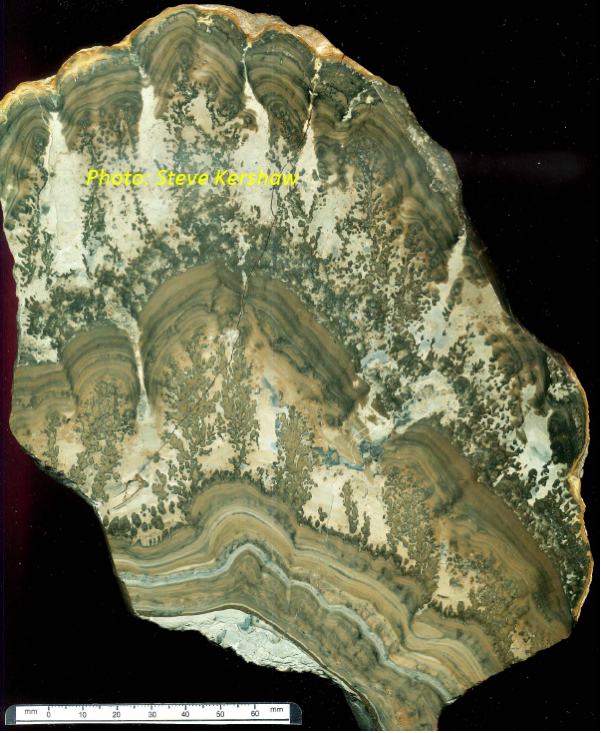
Figure 1: part of a dome of Cotham Marble, showing its growth on a dome-shaped substrate made of shelly lime mudstone. We can presume that the substrate was stabilised and possibly quite firm, prior to stromatolite development because soft mud may be reasonably assumed not to have been able to support a heavy structure forming on top of it. Note how the Cotham Marble here is made of three layers of laminated lime mudstone with two intervening layers of a kind of clotted fabric, that is best described as thrombolite. Thrombolite and stromatolite are two major kinds of rock created by the action of microbial organisms, so in reality the Cotham Marble stromatolite is a hybrid structure, so calling it a stromatolite is a simplification of the huge complexity it contains. A better word is microbialite. Notice that the thrombolitic branches are orientated vertically, although in their basal portions they are not vertical; they curve to a vertical attitude from an original sloping surface. Whether this is evidence that they were composed of light-seeking organisms (thus possibly photosynthetic) is open to interpretation; there isn't any primary evidence that they actually were photosynthetic. One idea is that the thrombolitic portions formed as a response to increased sedimentation between the three layers of laminated material, but again, because the thrombolitic layers are made of small blobs and branches, they have a different structure from the laminated layers, and so there is not proof that the thrombolitic layers were actually related to episodes of increased sedimentation. Finally, note that the laminated layers have small burrows at certain levels, suggesting a cessation of accumulation of sediment and thus short periods when the stromatolite surface was exposed to the browsing influence of animals that ate its surface.
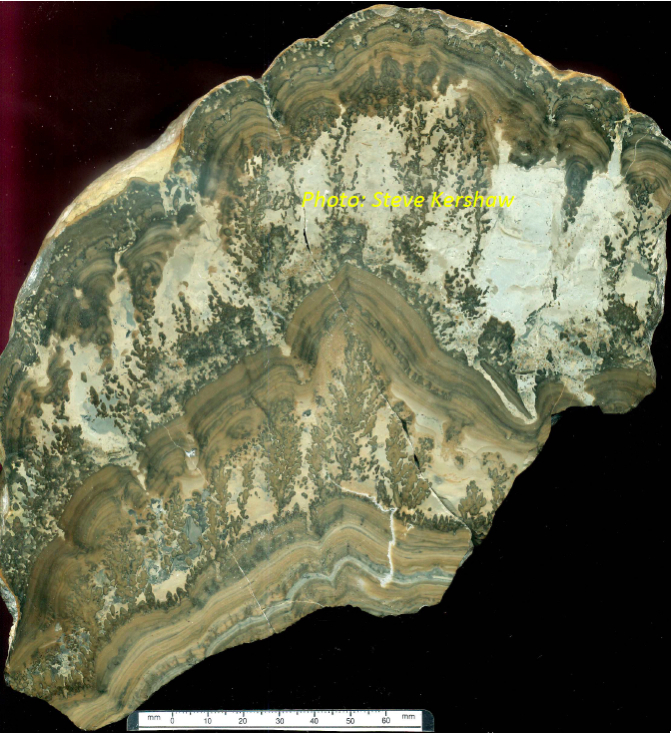
Figure 2: Another piece, similar to Figure 1, showing the structure described above.
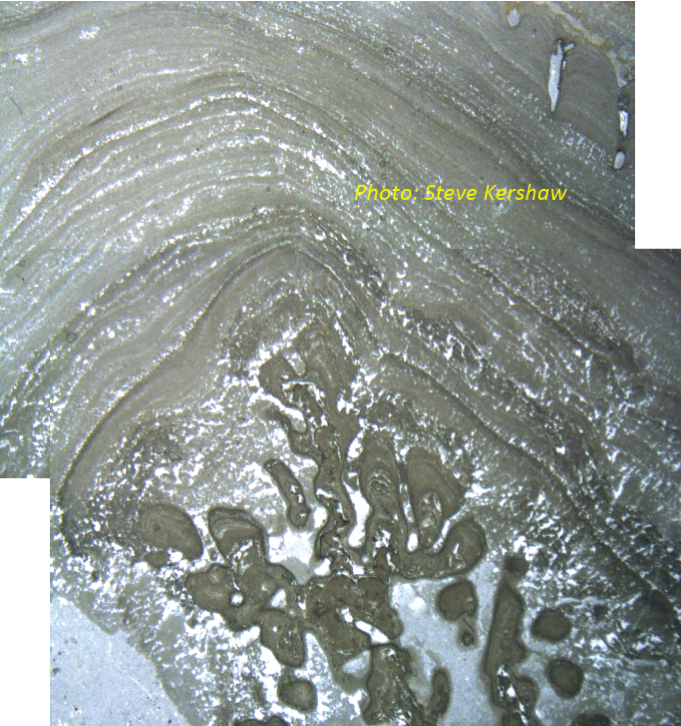
Figure 3: Microscope thin section photo of part of a microbial stromatolitic dome in the middle of the Cotham Marble bed. Note the lobate branching part, which could be called a thrombolite, is actually made of layers and therefore can also be considered a branching stromatolite. Such terminology of microbialites is confusing and remains a challenge for researchers! Photo is 17 mm wide.
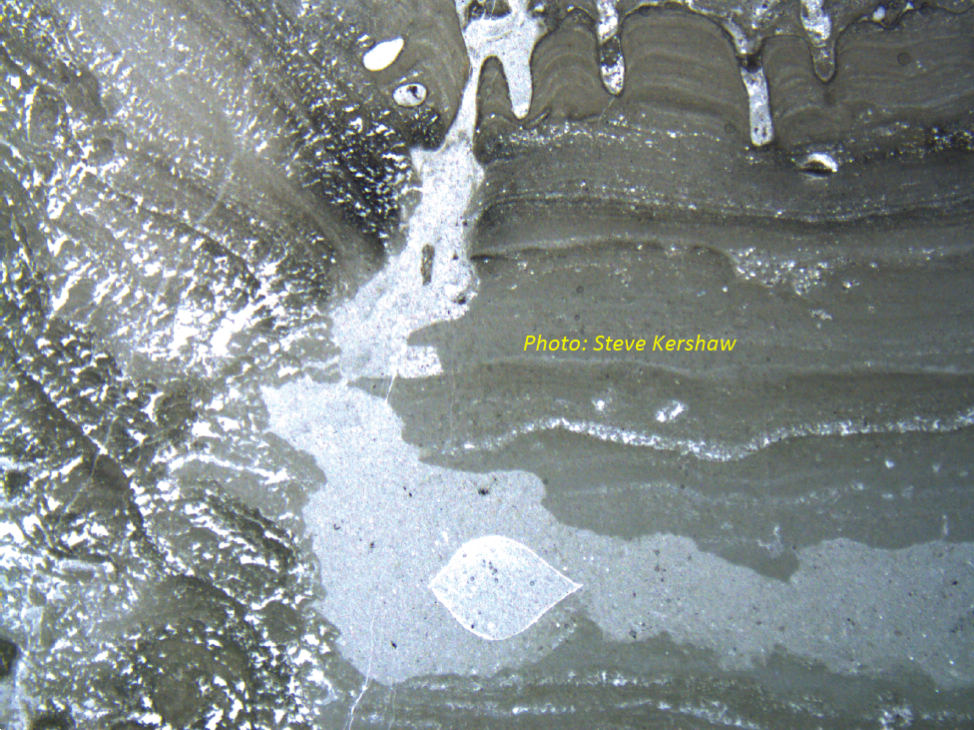
Figure 4: Microscope thin section photo of part of a microbial stromatolitic dome at the top of the Cotham Marble. Note the tiny stromatolitic columns that define the very top of the Marble, and the stromatolitic layering throughout the photo. The light area in the middle that has a cross section of a lens-shaped object [a shelly fossil] is a burrow in the stromatolite filled with lighter coloured carbonate mud. Photo 16.5 mm wide.
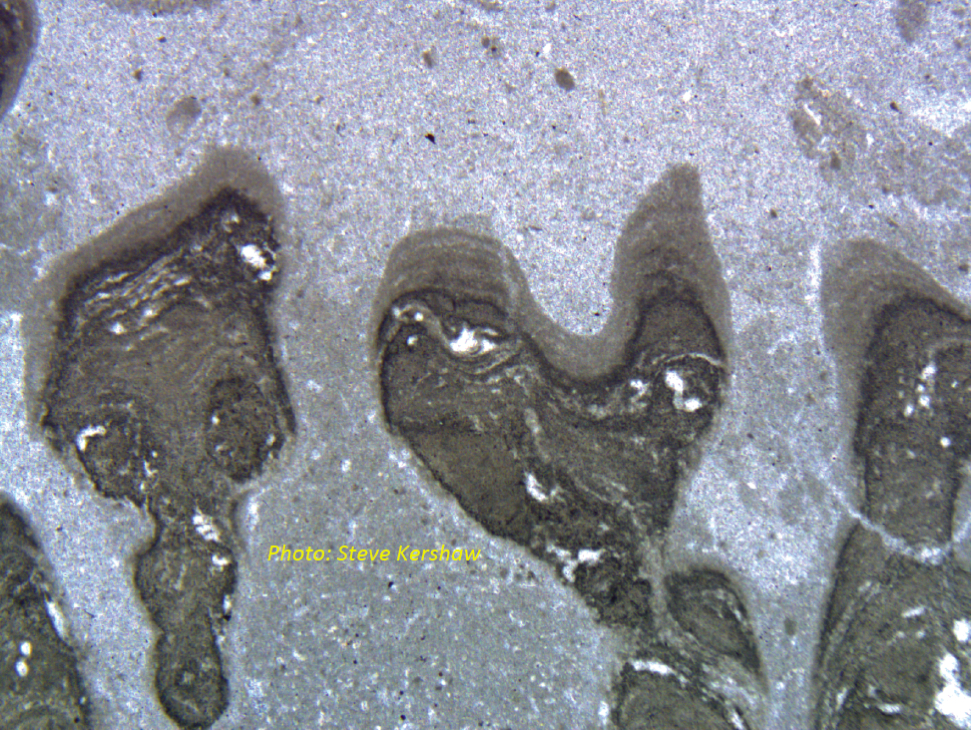
Figure 5: Microscope thin section photo of part of the microbial branches. Note the layering within the branches that suggest these are microstromatolites. Also note that the structure seems to have two phases: a darker coloured earlier phase and a lighter coloured later phase. Such features indicate the intricacies of the development of the Cotham Marble at a microscopic scale. Photo 6.2 mm wide.
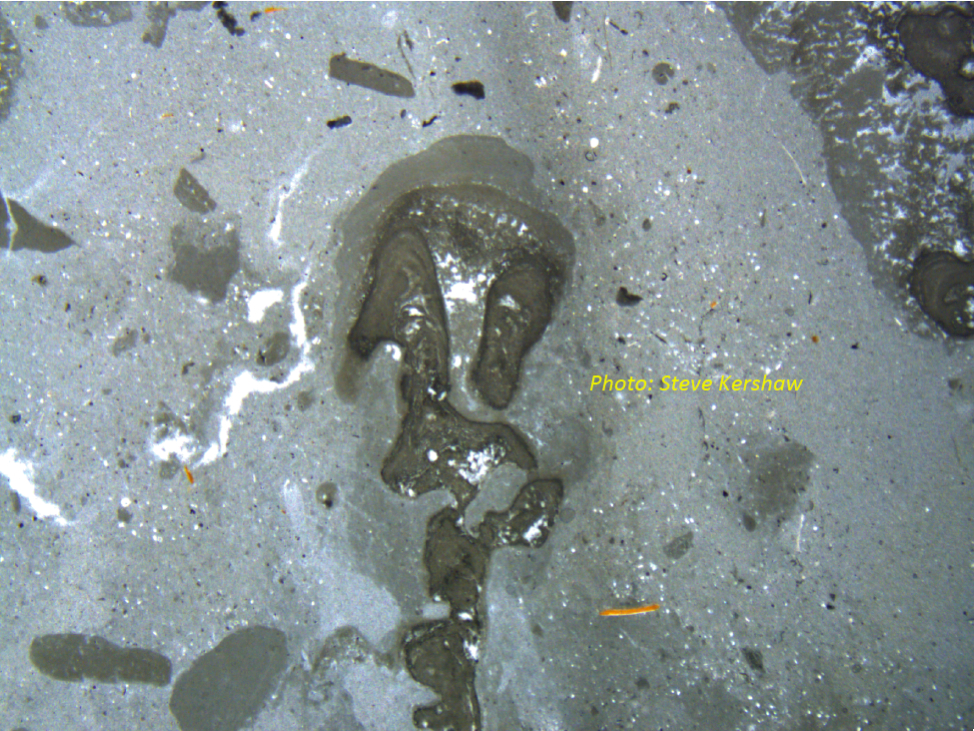
Figure 6: Microscope thin section photo of another part of the microbial branches, but in contrast to Fig. 5, here the branches seem to have THREE phases of growth, again demonstrating the complexity of this rock. Photo 16.5 mm wide.
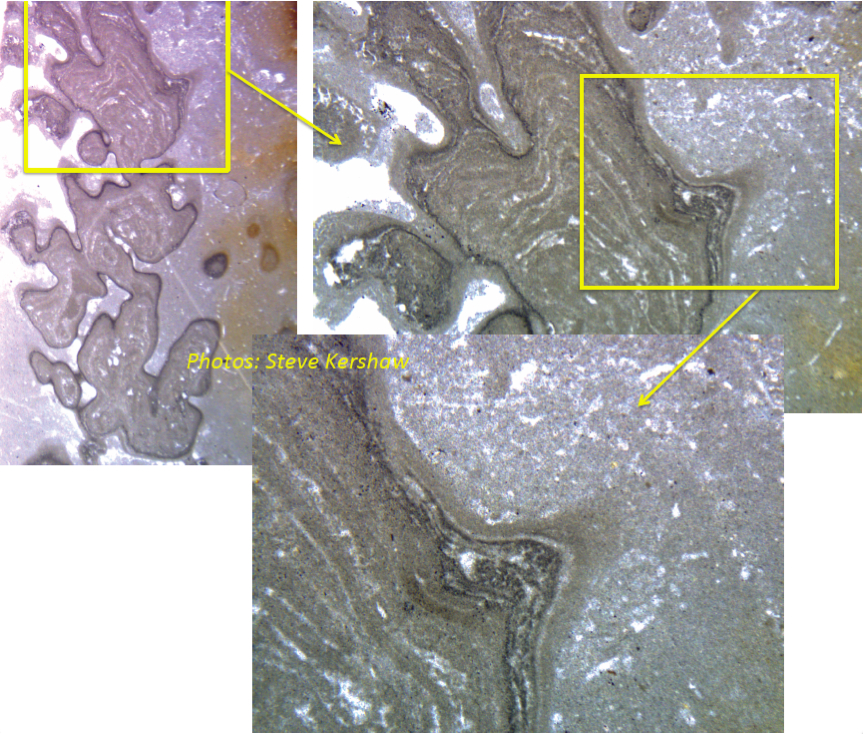
Figure 7: Microscope thin section photo of yet another part of the microbial branches, showing the complex microstructure of these branching microstromatolites. The top right photo is 6.5 mm wide.
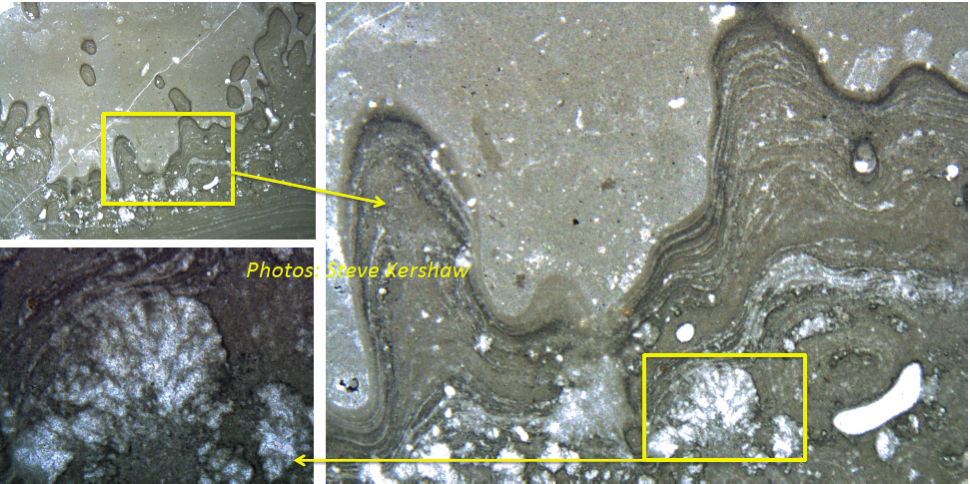
Figure 8: Microscope thin section photo of the area near the base of the Cotham Marble, showing the topmost part of the basal laminated layer, and the beginning of the branching structure. These small columns are referred to as “hedges” in the colloquial terminology, using the metaphor of Landscape Marble that the Cotham Marble is also known by. The bottom left photo shows a peculiar rounded object that has structure within it, one of many of such features in this part of the Marble. It is not clear what these are but they do resemble some microbial structures seen in limestones. The right hand photo is 6.5 mm wide.
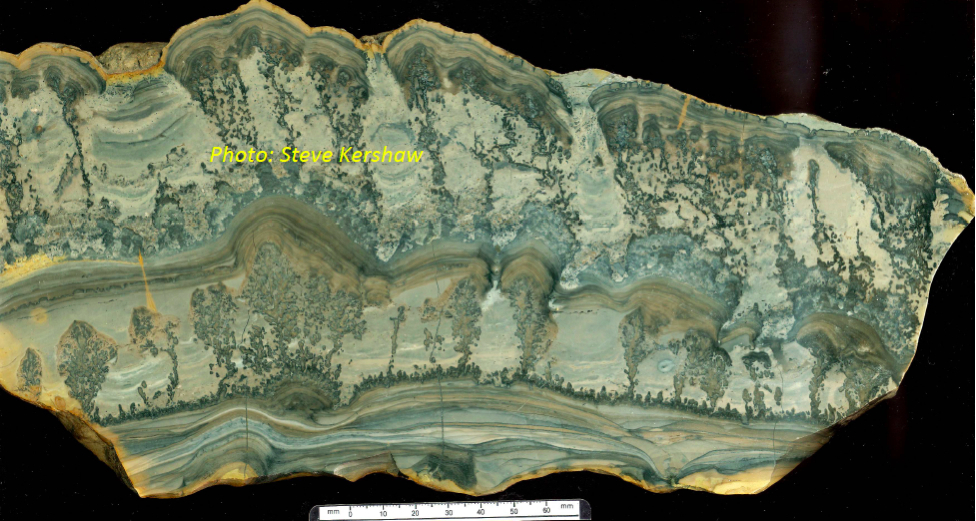
Figure 9: a flat piece of Cotham Marble, but notice that in the lower part, the branching fabrics are orientated vertically, yet in the upper part they are tilting at a small angle to the left. This suggests that the two parts of the deposit formed at different angles to the horizontal, since we assume the thrombolitici branching fabrics grew vertically. This introduces an interesting complexity into the process of construction of this piece of Cotham Marble, that may have shifted its orientation as it grew. If so, we can only speculate as to how it happened: a storm? an area of soft mud beneath the stromatolite causing it to settle as its mass developed during growth? Instability in its base causing it to shift. In this sample, and in Figures 1 and 2, note that the lower thrombolitic layer has a more robust appearance than the upper thrombolitic layer, suggesting a different growth control. Also note that the lowest laminated layer has cross-cutting layers in its construction. It is quite possible that this layer was built during a period of higher energy on the substrate, causing minor erosion of the individual sublayers from which it is made. The yellowish tinge at the edges of this sample occur because the rock is partly weathered; the original colour is the grey, weathering to yellowish where exposed to water and the atmosphere. The upper thrombolitic layer has some areas lacking thrombolite branches, and in these areas the sediment has a downward-curving structure, as if it is infilling hollows between the thrombolite branches. Finally note the very top layer of this slab shows burrows, indicating its final upper surface was subjected to burrowing before the stromatolite was buried in later sediments (no longer present).
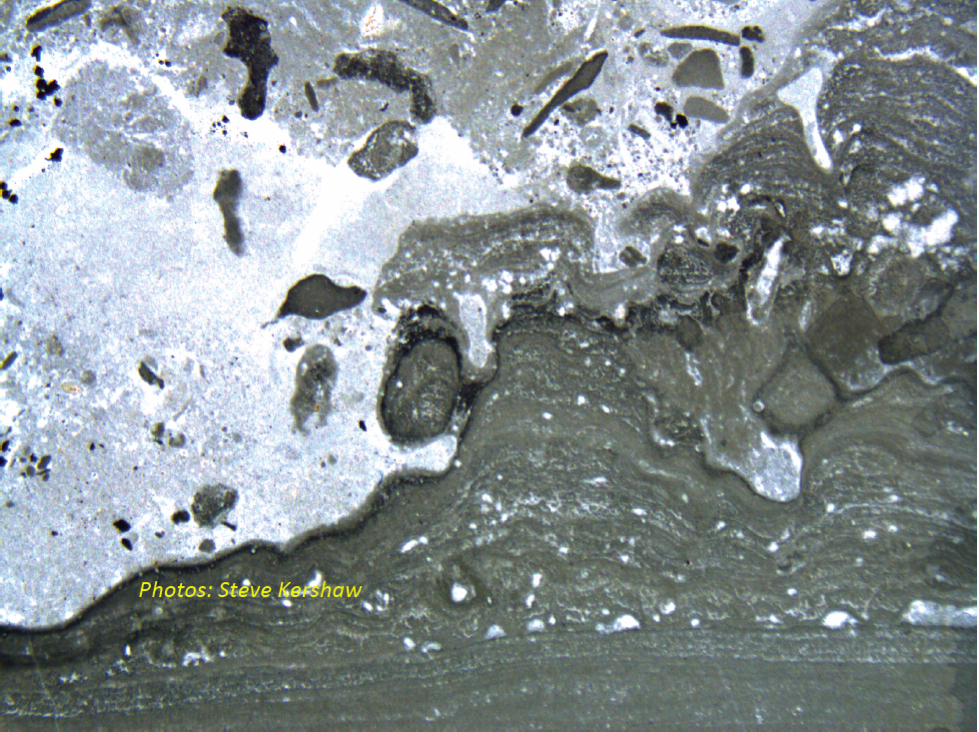
Figure 10: Microscope thin section photo of another part of the lower section of the Marble, here showing more of the “hedges” but also lots of small fragments accumulating in the sediment above the “hedges”. The “hedges” are the beginnings of tiny stromatolitic domes; note the occasional small circular holes in the structure; these are cross sections through a feature called “Microtubus”, a tube-shaped microfossil that grew within the Cotham Marble; the origin of Microtubus is debated.
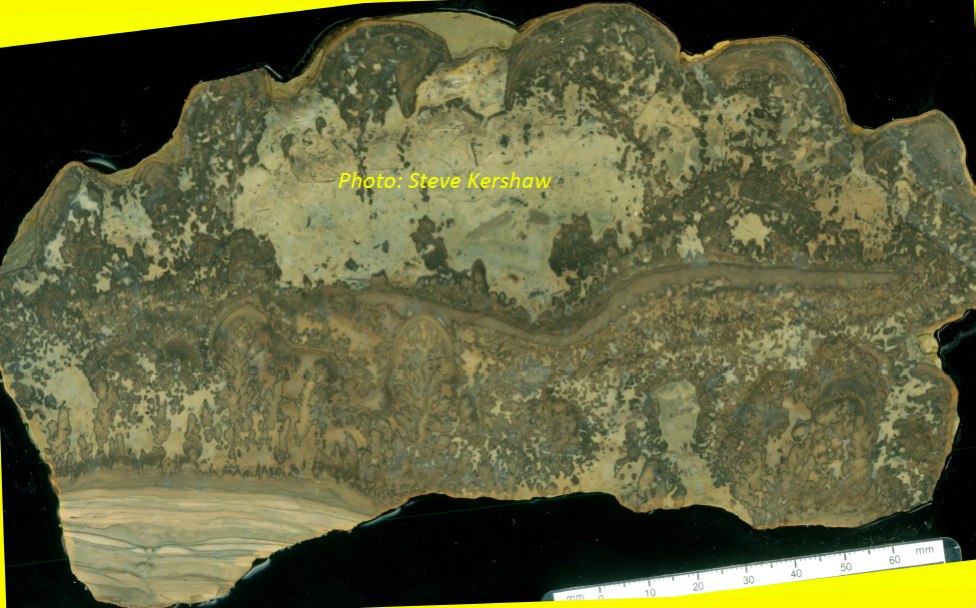
Figure 11: More complexity in Cotham Marble structure. Note that the lower part is missing in the middle and right in this partly broken sample, but we can assume that the lowest laminated layer originally extended across the sample. In the lower right-hand quarter is an odd, vertically-elongated, area of grey sediment that seems to be encrusted by basal parts of thrombolite branches; this may be an eroded piece of sediment that is encrusted by the thrombolite. In the lower left-hand quarter, the thrombolite seems to be developing into heads of thin stromatolite, prior to the formation of the middle layer of stromatolite, which is here represented as only a thin unit. The upper layer of thrombolite and stromatolite also show poor growth, with lots of sediment accumulation containing thin shells of molluscs. Note also that the upper stromatolite has an overlain patch of fine-grained lime mudstone on top of it, showing that the Cotham Marble here was buried in such material, maybe as sea level rose in the intertidal flat where the Cotham Marble microbialites grew.

Figure 12: A slab of Cotham Marble cut from the same piece shown in Figure 4, therefore very close to the location of Fig. 4 and showing similar features.
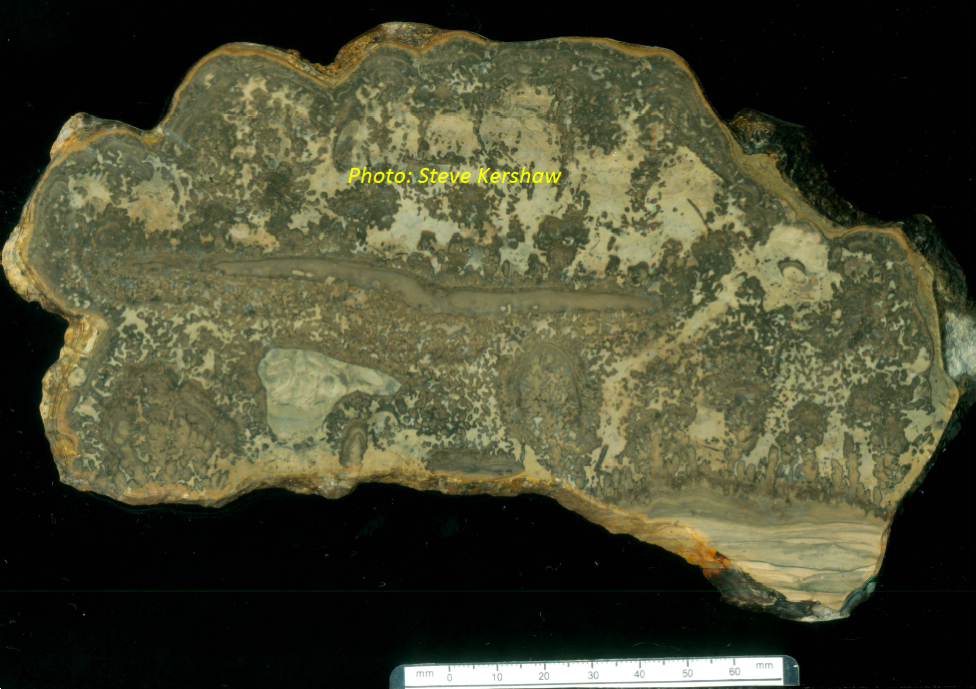
Figure 13: Another slab from the same sample, here showing what looks like a distinct rounded pebble of lime mudstone encrusted by thrombolite in the lower-left quarter; this is evidence that the environment of formation of the Cotham Marble included events of erosion and transport of pebbles into the area where the stromatolites grew.
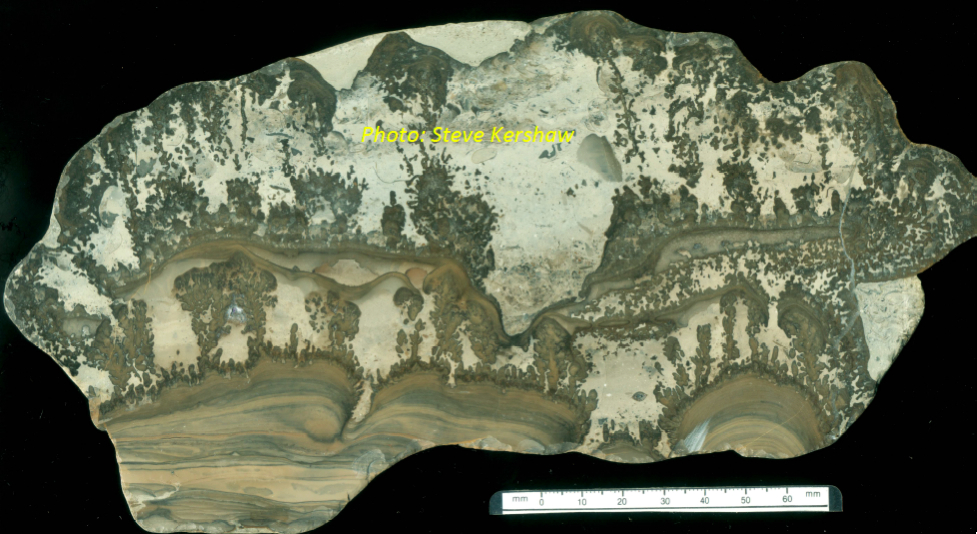
Figure 14: A fourth piece from the same sample, showing more of the same features as in the previous 3 Figures. Also note that the top surface of the Cotham Marble here has been eroded prior to final burial in plain grey-coloured lime mudstone.
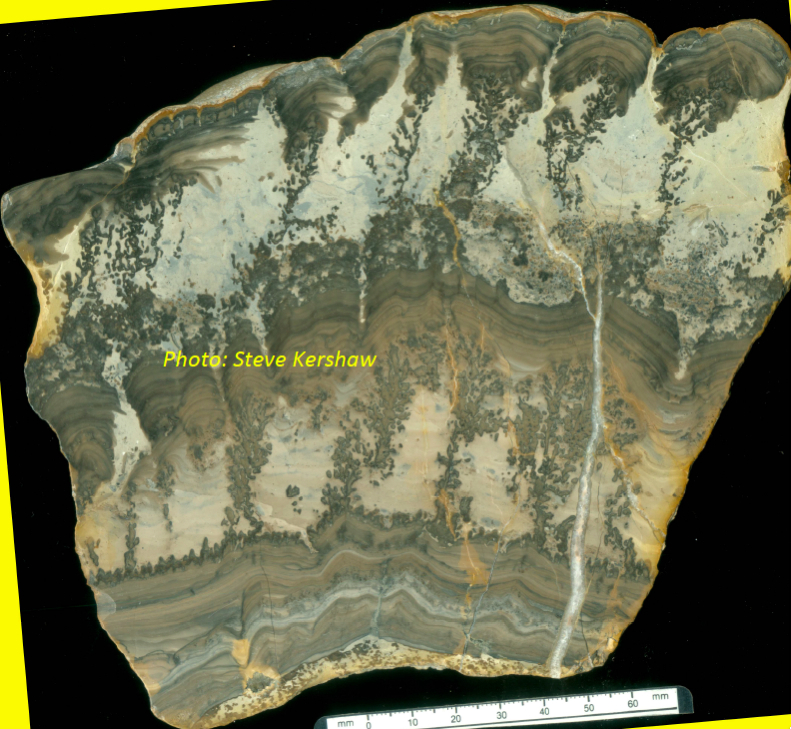
Figure 15: A slab of flatter Cotham Marble, but note the orientation of its features suggest it varied in its attitude as it grew, rather like in Fig. 9. Whether or not this is due to actual physical movement of the stromatolite masses as they developed is open to interpretation.
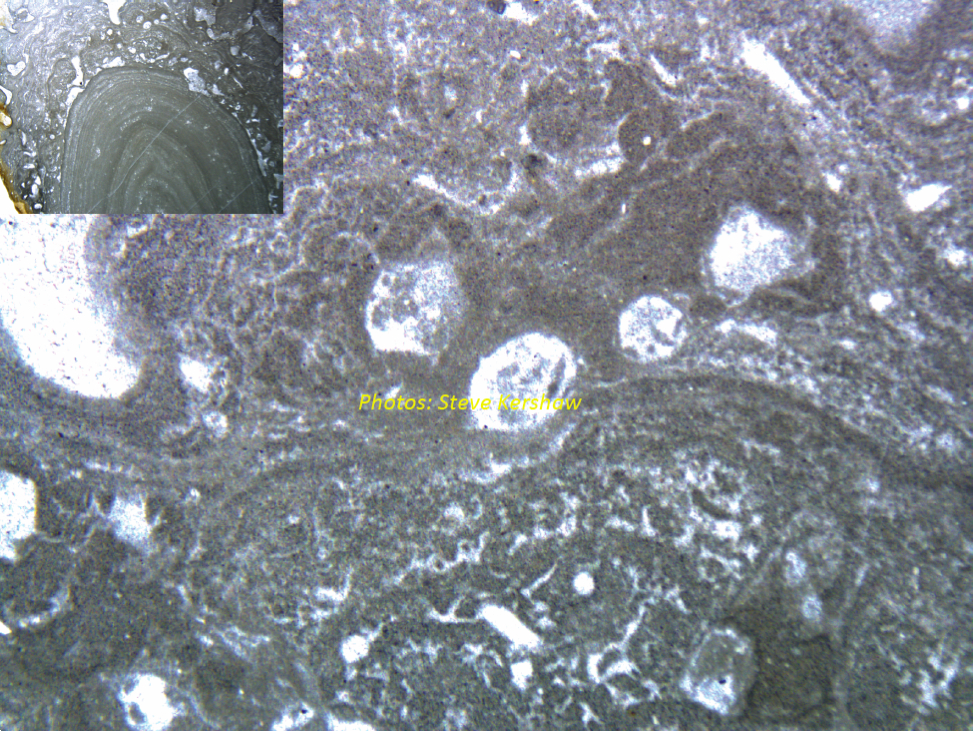
Figure 16: Thin section showing the top part of a stromatolitic dome that is overgrown by structure that is more clearly of thrombolitic character, within which are some Microtubus cross sections.
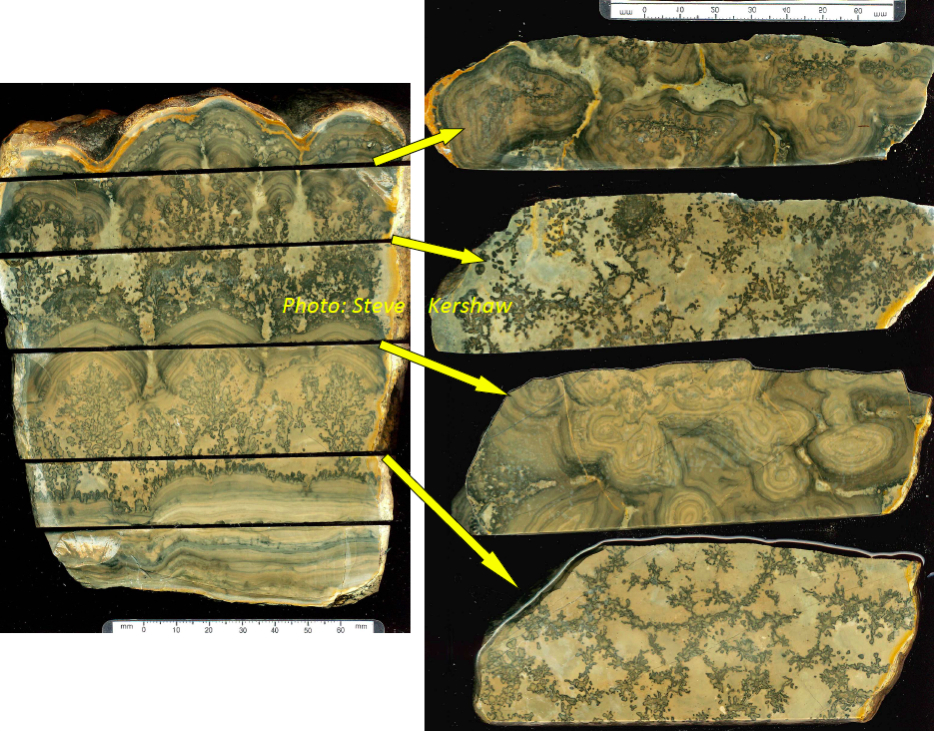
Figure 17: A very nice piece of Cotham Marble that has been sectioned horizontally at certain levels, so that the plan view can be seen at different levels within its structure. Note that the branching parts are polygonal in construction when seen in plan view; they may be related to the environment of formation in a tidal flat area where polygons are commonly related to dehydration of the sediment.

Figure 18: Not all the Cotham Marble contains two layers of thrombolite and three layers of stromatolite; in some cases only the lower two stromatolite layers, with the intervening lower thrombolite, are found. This is called "single marble" in contrast to the "double marble" of the previous photos. Such variations demonstrate that the conditions of growth of the Cotham Marble microbialites changed from place to place. Note that the right hand photo is a plan view section and demonstrates the polygonal nature of its formation.

Figure 19: A piece of single marble (that is only one layer of stromatolite, in contrast to the “double” marble of previous photos in this display), cut horizontally in three places and all six of the cut surfaces shown in plan view. This figure demonstrates that the polygonal character of the Cotham Marble extends through its vertical section and is thus a key component of its growth.
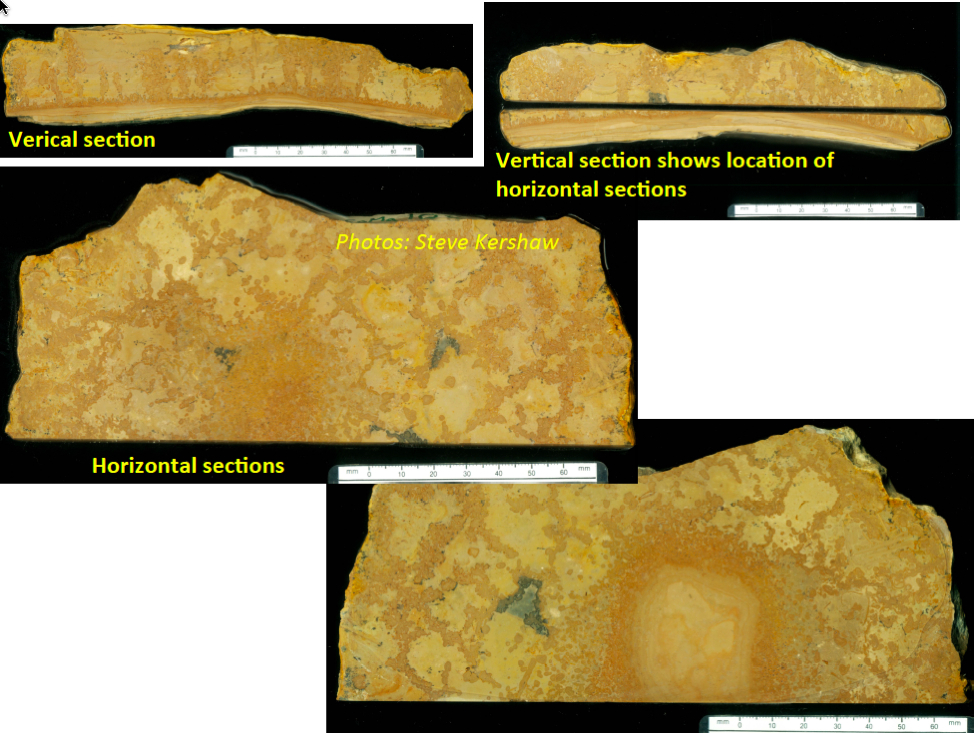
Figure 20: Another example of single marble, cut to show its plan view and its polygonal character.

Figure 21: The two upper photos show vertical sections of a fragment of Cotham Marble with only the branching features shown. In the lower part of each photo is an irregular eroded patch of lime mudstone, with thrombolite encrusted on it. The lower two photographs are from the upper right photo, along the prominent cut, and show the structure in plan view. Once again, even in this small piece, the polygonal character can be appreciated.

Figure 22: Microscope thin section cut from the upper block in Figure 21. You can see the eroded fine-grained limestone in the lower middle and left (as in Figure 21), that is encrusted by the microbialite. The total width of this composite photo is about 30 mm.
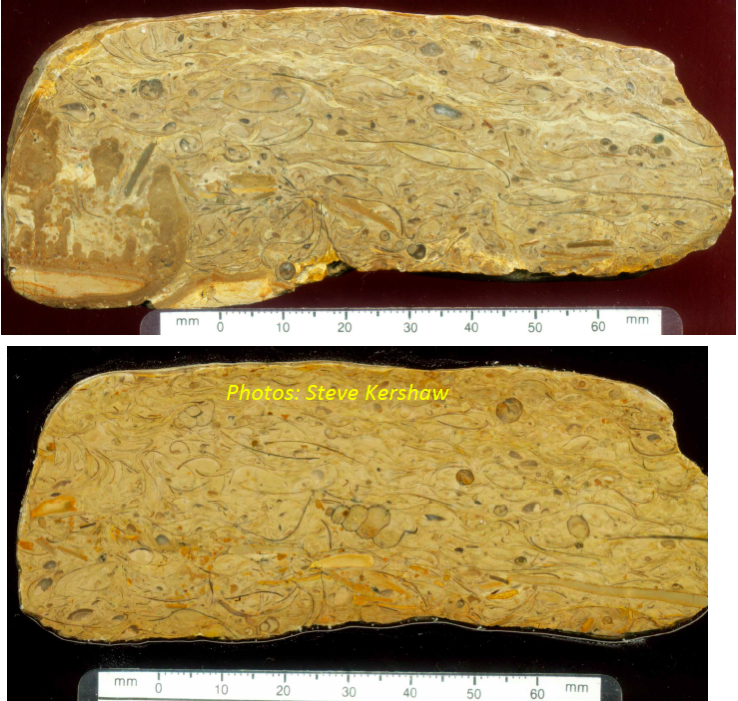
Figure 23: The Cotham Marble is associated with marine fossils. These two vertical sections show bivalve and gastropod molluscs (=clams and snails) and the edge of a piece of single marble on the left hand side of the upper photo. The fossil molluscs are debris in these slabs, indicating transport energy across the tidal flat where the Cotham Marble developed.
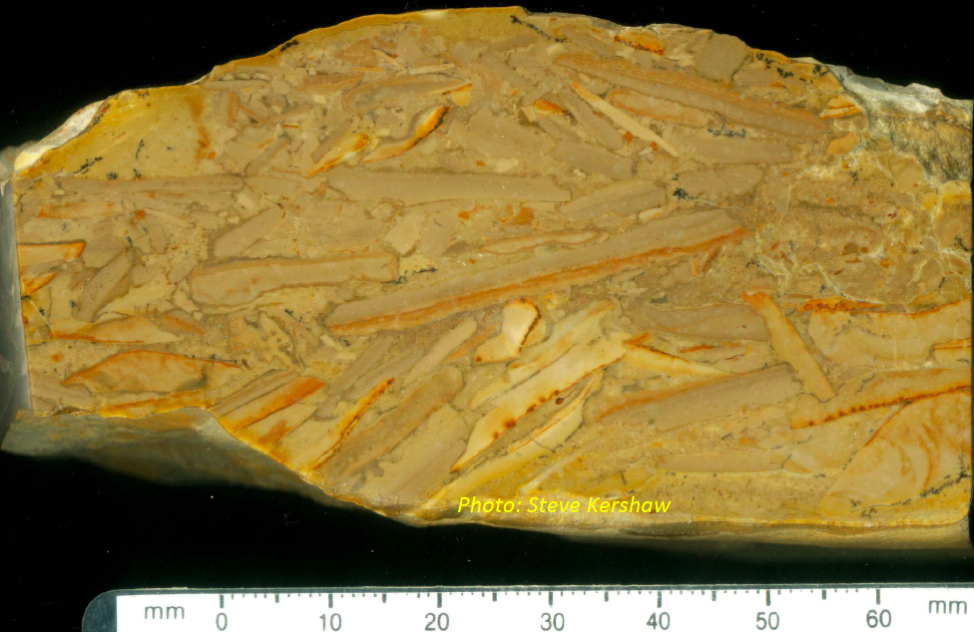
Figure 24: In places the layered parts of Cotham Marble are broken up into fragments and accumulated as in this vertical section. This is called "crazy marble" for obvious reasons. It forms because the lime sediment from which the rock is made becomes cemented into hard bands on the lagoon floor, and can easily broken up by storm action.
|
3) WHAT IS THE GEOLOGICAL SIGNIFICANCE OF THE COTHAM MARBLE
Cotham Marble has a special place in British stratigraphy because it has this remarkable structure illustrated above. Also, it is only about 20 cm thick, and yet is unique in the rock record. Its unusual character leads to questions about what controlled its formation. The traditional view is to consider it as being a widespread intertidal microbialite that grew in a large intertidal flat as various conditions coincided at the end of the Triassic Period of geological time: a flat landscape; a small sea-level rise to produce a tidal flat that persisted long enough to grow the deposit; and the development of microbial organisms in the right conditions to grow the Cotham Marble. Soon after the Cotham Marble was formed, the sea level rose and flooded much of the UK with sea water, leading to the famous fossil-rich Jurassic sediments that are so well known in the Jurassic Coast of Dorset, with its world heritage status.
|
To focus on the Cotham Marble, in recent years researchers have begun to recognise that layers of microbialites can form after mass extinctions have killed large numbers of species in a short period of time. The best example of microbialites after mass extinctions is the Permian-Triassic boundary, illustrated elsewhere in this website. Such ideas have prompted some researchers to interpret the controls of the Cotham Marble as being related to a mass extinction event that occurred just below the level of the Cotham Marble. This is the end-Triassic mass extinction, thought to be related to a giant volcanic eruption in the area now occupied by the northeastern Atlantic Ocean. Thus it is an easy conceptual step to make, to consider the Cotham Marble as a microbialite formed in a time when the sea was relatively de-populated following a mass extinction, allowing microbial organisms to grow in proliferation, with no vegetarian shelly organisms such as snails, to eat the microbia.
|
Considering the Cotham Marble as a post-extinction microbialite is part of the argument put forward by Yadira Ibarra and colleagues in 2014. However, there are also arguments against such an idea. These are that the Cotham Marble is remarkably thin, only 20 cm thick, it is not a continuous layer, because it forms in mounds. Another key point is that it occurs only in one relatively small area, in southwest England and south Wales; if it was a major microbial response to a mass extinction, it would be expected to have a much greater thickness and a much wider distribution. Finally, the photos presented in this website show how the Cotham Marble has a complex and varied microstratigraphy, which demonstrates that it developed and changed as it grew, suggesting the constructing microbia responded to small changes in the water around them. Such features might well be the record of shifting water levels and changing energy in a wide intertidal flat, and may or may not have anything to do with mass extinction. We will have to wait for more research to be done before a final decision can be made, but this text demonstrates how interpretations in geology are not necessarily clear cut, and we must be careful not to be too definite about interpretations until they are really tested. Thus the traditional idea of the Cotham Marble being an intertidal microbialite in a large lagoon, present in only one place for a short period of time, is still perfectly acceptable, yet it is also extremely important to test new ideas. There are many cases in the geological record where long-established ideas are questioned by people with new viewpoints and new data, which makes the study of geology a stimulating and rewarding scientific investigation.
|